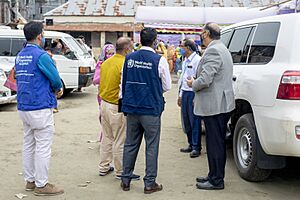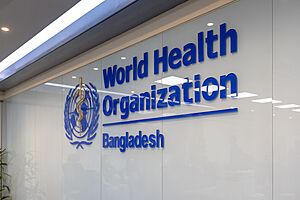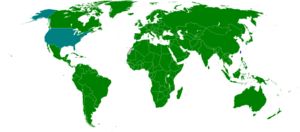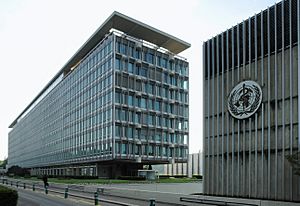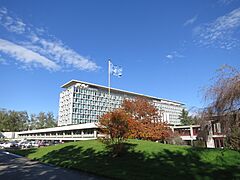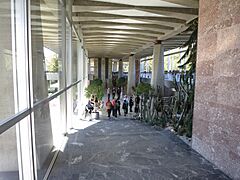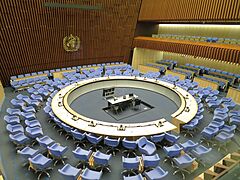World Health Organization facts for kids
 |
|
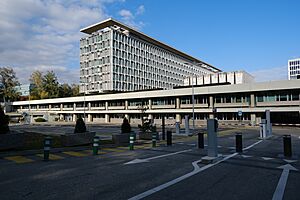
The headquarters in Geneva was designed by Jean Tschumi and inaugurated in 1966.
|
|
| Abbreviation | WHO |
|---|---|
| Pronunciation |
|
| Formation | 7 April 1948 |
| Type | United Nations specialized agency |
| Legal status | Active |
| Headquarters | Geneva, Switzerland 46°13′56″N 06°08′03″E / 46.23222°N 6.13417°E |
|
Director-General
|
Tedros Adhanom Ghebreyesus |
|
Deputy Director General
|
Michael Ryan |
|
Parent organization
|
United Nations Economic and Social Council |
|
Budget
|
$6.83 billion (2024–2025) |
The World Health Organization (WHO) is a special agency of the United Nations. It works to solve health problems around the world and helps during health emergencies. Its main office is in Geneva, Switzerland. WHO also has 6 regional offices and 150 local offices worldwide. Only countries can join WHO, and it is the largest international health group.
WHO's main goal is to help everyone in the world be as healthy as possible. They say health is "a state of complete physical, mental and social well-being and not merely the absence of disease or infirmity." WHO helps control diseases that spread easily, improves health training for doctors and nurses, and sets global rules for health products.
The WHO started on 7 April 1948. It took over the work of earlier health groups, including the League of Nations' Health Organization. The agency began its important work in 1951 with a lot of money and expert help.
WHO's job is to make sure people are healthy and safe, especially those who are most in need. It gives expert advice to countries, creates international health rules, gathers information on global health issues, and is a place for health discussions. Its main report, the World Health Report, shares information on health topics worldwide.
WHO has helped with many big health successes. These include getting rid of smallpox, almost getting rid of polio, and creating an Ebola vaccine. Right now, WHO is focused on diseases that spread, like HIV/AIDS, Ebola, malaria, and tuberculosis. They also work on diseases that don't spread, like heart disease and cancer. Other important areas are healthy eating, good food, and making sure everyone has enough food. WHO also promotes health care for everyone, watching out for health risks, helping during health emergencies, and generally making sure people are healthy and happy.
The World Health Assembly (WHA) leads WHO. It is made up of representatives from its 194 member countries. The WHA chooses 34 health experts for an executive board. It also picks WHO's main leader, the director-general (who is currently Tedros Adhanom Ghebreyesus from Ethiopia). The WHA sets goals, decides what WHO will do, and approves its budget. WHO gets most of its money from member countries and private donations.
How the World Health Organization Started
Early Health Meetings
The first International Sanitary Conferences (ISC) happened on 23 June 1851. These were meetings that continued until 1938. The first meeting in Paris was mostly about cholera, a disease that was a big worry for many years. Because scientists weren't sure how many diseases spread, it was hard for countries to agree on what to do.
It took 41 years and seven meetings before countries signed an international agreement. The seventh meeting in Venice in 1892 led to a rule about checking ships in the Suez Canal. This was to stop cholera from spreading.
Five years later, in 1897, sixteen countries signed an agreement about the bubonic plague. Later meetings talked about other diseases like yellow fever, leprosy, and typhoid. Because these conferences were successful, other health groups like the Pan-American Sanitary Bureau (1902) and the International Office of Public Hygiene (1907) were created. After World War II, the United Nations brought all these health groups together to form WHO.
WHO has been very important in helping the world deal with the COVID-19 pandemic. It gave important advice on how to stay safe, supported research for vaccines, and helped share vaccines through programs like COVAX.
Creating the WHO
In 1945, during a United Nations meeting, a delegate from China named Szeming Sze talked with delegates from Norway and Brazil. They wanted to create a global health organization under the new United Nations. After some effort, a plan was approved to hold an international health meeting. Using the word "world" instead of "international" showed that the organization wanted to help everyone globally.
The official document to create the World Health Organization was signed by all 51 United Nations countries and 10 other countries on 22 July 1946. This made it the first special agency of the United Nations that every member joined. WHO officially started its work on 7 April 1948, which is now celebrated as World Health Day. WHO formally began its operations on 1 September 1948.
The first meeting of the World Health Assembly ended on 24 July 1948. They set a budget of $5 million for 1949. G. Brock Chisholm became the first director-general of WHO. Their first goals were to control malaria, tuberculosis, and to improve the health of mothers and children, nutrition, and clean environments. One of their first actions was to collect accurate information on how diseases spread. The WHO logo has the Rod of Asclepius, which is a symbol for healing.
In 1959, WHO signed an agreement with the International Atomic Energy Agency (IAEA). This agreement helps both groups work together on health topics related to atomic energy. It also makes sure WHO can still do its own health work, including research, in all areas.
What the World Health Organization Does
Helping People Stay Healthy
WHO's main goal is to help everyone achieve the best possible health. They do this by:
- Leading important health efforts and working with partners.
- Guiding health research and sharing valuable knowledge.
- Setting health rules and making sure they are followed.
- Giving advice on health policies based on facts.
- Providing expert help to countries and building strong health systems.
- Watching health situations and understanding health trends.
- Helping countries keep track of important life events like births and deaths.
Many new groups now work in global health, like the World Bank and the Bill & Melinda Gates Foundation. This has changed WHO's role as a main leader. Because of this, there are ideas to change how WHO works and what it focuses on.
WHO also encourages people to be more involved in health decisions. This fits with the Sustainable Development Goals of the UN. It means giving people, communities, and groups a say in health choices at all levels.
Fighting Diseases That Spread
In the 1970s, WHO changed its goal for malaria from getting rid of it completely to controlling it. WHO's Global Malaria Programme tracks malaria cases and helps solve problems in control plans. WHO also works to prevent malaria using mosquito nets treated with bug spray and special medicines, especially for pregnant women and young children.
In 1988, WHO started the Global Polio Eradication Initiative to get rid of polio. They have helped reduce cases by 99% since working with groups like Rotary International and UNICEF. As of 2011, they worked to vaccinate young children and stop polio from coming back in countries that were declared "polio-free." Polio is now almost gone, thanks to a global vaccination effort.
Between 1990 and 2010, WHO helped reduce deaths from tuberculosis by 40%. Since 2005, over 46 million people have been treated, and about 7 million lives saved, because of WHO's advice. This includes working with governments, early diagnosis, standard treatments, and tracking the disease.
In 2007, WHO helped develop influenza vaccines through studies with many experts. A pandemic of the H1N1 flu virus was declared in April 2009. By 2010, the H1N1 flu was in a "post-pandemic" period. Some people said WHO had made the danger seem worse, but experts said the 2009 pandemic led to amazing teamwork between health groups, scientists, and vaccine makers. This helped create vaccines quickly.
The WHO budget for 2012–2013 focused on five areas. Two of these were about diseases that spread: reducing the problems caused by these diseases in general, and fighting HIV/AIDS, malaria, and tuberculosis in particular.
As of 2015, WHO worked with the UNAIDS network to involve different parts of society in dealing with the effects of HIV/AIDS. WHO set goals to reduce new HIV infections in young people and children, and to reduce HIV-related deaths.
Helping with Long-Term Health Conditions
One of WHO's main goals is to prevent and reduce "disease, disability and early deaths from long-term diseases, mental health issues, violence, and injuries." These problems cause almost 71% of all deaths worldwide.
WHO also works to study substances for international drug control. Through its expert committee, it can suggest changes to how certain substances are controlled. This committee looks at how these substances affect public health and their potential for harm, as well as their medical benefits.
Healthy Environments
WHO believes that 12.6 million people died in 2012 because they lived or worked in unhealthy environments. This is almost 1 in 4 of all global deaths. Things like air, water, and soil pollution, chemical exposure, and climate change can lead to over 100 diseases and injuries.
In 2018, WHO held its first global meeting on air pollution and health. It focused on improving air quality, fighting climate change, and saving lives.
Life Stages and Healthy Habits
WHO works to improve health during important life stages, like pregnancy, childhood, and the teenage years. They also promote healthy aging for everyone.
They also try to prevent or reduce health risks from things like tobacco, alcohol, unhealthy diets, and not being active enough.
WHO works to improve nutrition, food safety, and making sure everyone has enough food. This helps public health and sustainable development.
In April 2019, WHO suggested that children aged two to five should spend no more than one hour a day looking at screens. Children under two should not have any screen time.
In January 2025, WHO released new advice to reduce salt intake. They strongly suggest eating less than 2 grams of sodium per day. They also recommend using lower-sodium salt substitutes that contain potassium for adults, except for pregnant women or those with kidney problems.
Surgery and Injury Care
The World Health Organization promotes road safety to reduce injuries from traffic accidents. They also work on global surgery efforts, including emergency care, injury care, and safe surgery. The WHO Surgical Safety Checklist is used worldwide to make patient care safer.
Helping in Emergencies
WHO's main goal during natural disasters and other emergencies is to work with countries and other groups. They aim to "reduce avoidable loss of life and the burden of disease and disability."
On 5 May 2014, WHO announced that the spread of polio was a world health emergency. Outbreaks in Asia, Africa, and the Middle East were very serious.
On 8 August 2014, WHO declared that the spread of Ebola was a public health emergency. This outbreak started in Guinea and spread to nearby countries like Liberia and Sierra Leone. The situation in West Africa was very serious.
Changes After the Ebola Outbreak
After the 2014 Ebola outbreak in West Africa, WHO was criticized for being too slow and not having enough money or staff.
An internal WHO report on the Ebola response showed that not enough funding and weak health systems in developing countries were the main problems. In 2015, Director-General Margaret Chan announced a $100 million fund for quick responses to future emergencies. The Health Emergencies Programme was created to help WHO take direct action during health crises.
Response to the COVID-19 Pandemic
WHO created a special team on 1 January 2020, one day after China told them about a new pneumonia outbreak. On 5 January, WHO told all member countries about the outbreak and gave advice on how to respond. They confirmed the first infection outside China. On 14 January 2020, WHO said that early checks by Chinese officials found no clear sign of the new coronavirus spreading from person to person. The same day, WHO warned of limited human-to-human spread, and confirmed it a week later. On 30 January, WHO declared a Public Health Emergency of International Concern (PHEIC), which is a "call to action" for the world. On 11 March, they called it a pandemic.
WHO led the global response to the COVID-19 pandemic and managed over 35 other emergency operations for diseases like cholera and measles. Some people criticized WHO for praising China's response while trying to balance its relationships with the United States and China. However, experts like David L. Heymann said that "China has been very transparent and open in sharing its data."
WHO faced criticism from the United States' Trump administration. On 14 April 2020, President Donald Trump said he would stop US funding to WHO. He wanted to review its role in "mismanaging and covering up the spread of the coronavirus." Many world leaders and health experts disagreed with Trump's announcement. WHO called it "regrettable" and defended its actions in warning the world about COVID-19. On 7 July 2020, President Trump officially told the UN that the United States would leave WHO. However, President Joe Biden, who became president after Trump, cancelled this plan in January 2021 and said the US would start funding WHO again.
In May 2023, WHO announced that COVID-19 was no longer a worldwide health emergency.
In January 2025, during his second term, President Trump signed an order to withdraw the United States from the WHO again. He said it was because of how WHO handled the COVID-19 pandemic. On 5 February 2025, Argentinian president Javier Milei also announced that Argentina would be leaving WHO.
Health Rules and Plans
WHO helps governments create health policies in two ways: first, by looking at the social and economic reasons for health problems and creating plans that help everyone, especially those in need. Second, by promoting healthier environments and working with all parts of society to fix the root causes of environmental health threats.
The organization creates and shares tools and rules based on evidence to help countries make health policy choices. It checks how the International Health Regulations are followed and publishes different ways to classify medical information. These include the International Statistical Classification of Diseases (ICD) and the International Classification of Functioning, Disability and Health (ICF). Other international plans from WHO include rules for marketing baby formula (1981), the Framework Convention on Tobacco Control (2003), and rules for hiring health workers internationally (2010). They also have a list of important medicines for adults and children. An international agreement on preventing and preparing for pandemics is also being discussed.
WHO also works to improve health services, including how they are managed, funded, and staffed. They also try to make sure medical products and technologies are available and of good quality. WHO works with donors and governments to improve how they report on using research.
Digital Health
For digital health, WHO works with the International Telecommunication Union (the UN agency for technology). This includes projects like "Be Health, Be Mobile" and a group focused on using Artificial Intelligence for Health.
Special Health Programs
WHO has created several special programs to help countries improve health:
- ACTIVE (for physical activity)
- HEARTS (for heart diseases)
- MPOWER (for tobacco control)
- REPLACE (for harmful fats)
- SAFER (for alcohol)
- SHAKE (for reducing salt)
How WHO is Run
The last two of WHO's main focus areas are about WHO itself:
- "To lead, strengthen, and work with countries, the United Nations, and other groups to achieve WHO's goals in global health."
- "To make WHO a flexible, learning organization so it can do its job better."
Working with Partners
WHO and the World Bank lead the International Health Partnership (IHP+). This group includes governments, aid agencies, and other organizations that want to improve health in developing countries. They work together to use international rules for aid and development in health.
WHO gets help from famous scientists and experts for its work. These include the WHO Expert Committee on Biological Standardization and the WHO Expert Committee on Leprosy.
WHO also runs the Alliance for Health Policy and Systems Research, which aims to improve health policies and systems.
WHO works to make health research and information available in developing countries, for example, through the HINARI network.
WHO works with The Global Fund to Fight AIDS, Tuberculosis and Malaria, UNITAID, and the United States President's Emergency Plan for AIDS Relief to lead and fund HIV programs.
WHO created the Civil Society Reference Group on HIV. This group brings together other networks involved in making policies and sharing guidelines.
WHO, as part of the United Nations, works with UNAIDS to help develop HIV responses around the world.
WHO helps with expert partnerships through the Technical Advisory Committee on HIV. This committee creates WHO guidelines and policies.
In 2014, WHO published the Global Atlas of Palliative Care at the End of Life. This was done with the Worldwide Hospice Palliative Care Alliance, a group that works with WHO to promote care for people with serious illnesses.
Health Education and Action
Health education is about helping people take more control over their health and make improvements. WHO describes it as moving away from just focusing on personal actions to looking at wider community and environmental solutions.
Each year, WHO celebrates World Health Day and other special days focusing on a health topic. World Health Day is on 7 April, which is WHO's founding anniversary. Recent themes have included diseases carried by insects (2014) and healthy aging (2012).
Other official global health campaigns by WHO include World Tuberculosis Day, World Immunization Week, World Malaria Day, World No Tobacco Day, World Blood Donor Day, World Hepatitis Day, and World AIDS Day.
As part of the United Nations, WHO supports work towards the Millennium Development Goals. Three of these goals are directly related to WHO's work: reducing child deaths, reducing maternal deaths, and stopping the spread of HIV/AIDS. The other five goals also affect global health.
Handling Information and Publications
The World Health Organization collects health information in many ways. This includes the World Health Survey, which covers almost 400,000 people from 70 countries. They also have the Study on Global Aging and Adult Health (SAGE), which includes over 50,000 people over 50 years old in 23 countries. The Country Health Intelligence Portal (CHIP) helps people find information about health services in different countries. Countries use this information to set health priorities and plans.
WHO has published many tools for measuring health systems and health workers in countries. The Global Health Observatory (GHO) is WHO's main website for data and analysis on key health topics worldwide.
Tools like the WHO Assessment Instrument for Mental Health Systems (WHO-AIMS) and the WHO Quality of Life Instrument (WHOQOL) help collect health data. WHO also works with other agencies, like the Health Metrics Network, to provide good information for governments. WHO encourages countries to use and create research that meets their needs, through groups like the Evidence-Informed Policy Network (EVIPNet).
On 10 December 2013, a new WHO database called MiNDbank went online. It was launched on Human Rights Day and is part of WHO's QualityRights project. This project aims to stop human rights violations against people with mental health conditions. The database has a lot of information about mental health, disability, human rights, and the policies and laws in different countries. It also has important international documents. Users can look at health information from WHO member countries and find good examples of mental health practices.
WHO regularly publishes a World Health Report, which is its main publication. It includes expert opinions on a specific global health topic. Other WHO publications include the Bulletin of the World Health Organization and the Eastern Mediterranean Health Journal.
In 2016, the World Health Organization wrote a global health plan for HIV. This plan showed WHO's goal to end the AIDS epidemic by 2030. To reach these goals, the plan listed actions that countries and WHO can take, such as making health care available to everyone, making medicines easy to get, preventing diseases, and educating the public. The plan also noted that even though HIV spread is going down, there is still a need for resources, health education, and global efforts to end this epidemic.
WHO has a database for its Framework Convention on Tobacco, which helps make sure countries follow the rules. However, there have been some differences between this database and what countries report themselves.
WHO has been working to accept and include traditional medicine, like traditional Chinese medicine (TCM). In 2022, the new International Statistical Classification of Diseases and Related Health Problems, ICD-11, will try to combine traditional medicine classifications with those from evidence-based medicine. While Chinese officials have pushed for this change, some in the medical and scientific community have criticized WHO's support for traditional medicine. They say there isn't enough scientific proof, and it could harm wildlife used for traditional remedies. A WHO spokesperson said that including it "is not an endorsement of the scientific validity of any Traditional Medicine practice or the efficacy of any Traditional Medicine intervention."
International Agency for Research on Cancer
The International Agency for Research on Cancer (IARC) is a part of WHO. It studies and organizes research into what causes cancer. It also collects and publishes information about how often cancer happens around the world.
Its Monograph Programme finds things that can cause cancer and looks at environmental reasons for cancer in humans.
How WHO is Organized
The World Health Organization is part of the United Nations Development Group.
Membership
As of January 2025, WHO has 194 member countries. These are all United Nations member countries except for Liechtenstein, plus the Cook Islands and Niue. A country becomes a full member by agreeing to the WHO Constitution. As of January 2025, it also had two associate members, Puerto Rico and Tokelau. WHO's budget for 2022–2023 is paid by its 194 members and 2 associate members. Some other countries have "observer status," meaning they can attend meetings but not vote. Palestine and the Sovereign Military Order of Malta are observers. The Holy See (Vatican City) also attends as an observer. The government of Taiwan was allowed to participate as an observer from 2009 to 2016 under the name "Chinese Taipei" but has not been invited since. On 20 January 2025, U.S. President Donald Trump signed an order to start the 12-month process of the U.S. leaving WHO. On 5 February 2025, Argentinian president Javier Milei announced that Argentina would also be leaving WHO.
WHO member countries send representatives to the World Health Assembly, which is WHO's highest decision-making group. The World Health Assembly meets yearly in May and decides WHO's policies.
The executive board has 34 health experts. Their job is to carry out the decisions of the Assembly, give advice, and help with its work. As of June 2023, Dr. Hanan Mohamed Al Kuwari of Qatar leads the executive board.
Taiwan's Participation
The Republic of China (ROC), which now governs Taiwan, was a founding member of WHO. However, in 1971, the People's Republic of China (PRC) took over China's seat in the UN, and the ROC was removed from WHO.
In May 2009, WHO invited Taiwan's health department to attend the 62nd World Health Assembly as an observer under the name "Chinese Taipei". This was Taiwan's first time participating in WHO meetings since 1971. However, Taiwan's participation ended after the 2016 election, due to pressure from the PRC.
Political pressure from the PRC has stopped Taiwan from being a full member of WHO and other UN groups. From 2017 to 2020, WHO did not allow Taiwanese representatives to attend the annual Assembly.
In May 2018, WHO did not allow Taiwanese media to attend its annual assembly, reportedly because of demands from the PRC. Later that month, 172 members of the United States House of Representatives wrote to the WHO director-general, asking for Taiwan to be included as an observer. The United States, Japan, Germany, and Australia all support Taiwan's inclusion in WHO.
Pressure to allow Taiwan to join WHO grew because of the COVID-19 pandemic. Taiwan's exclusion from emergency meetings about the outbreak brought rare agreement from Taiwan's different political parties. Taiwan's main opposition party, the Kuomintang, was angry about being left out, saying that disease doesn't care about politics or borders. China again said it wasn't worried about Taiwan's inclusion, with its foreign minister saying that no one cares more about the health of the Taiwanese people than China's central government. During the outbreak, Canadian Prime Minister Justin Trudeau and Japanese Prime Minister Shinzo Abe supported Taiwan's participation in WHO. In January 2020, the European Union also supported Taiwan's participation in WHO meetings related to the coronavirus pandemic.
In a 2020 interview, Assistant Director-General Bruce Aylward seemed to avoid a question about Taiwan's response to the pandemic and its inclusion in WHO. This led to accusations about China's political influence over the organization.
Taiwan's good response to the 2019–20 COVID-19 pandemic has made its case for WHO membership stronger. Many experts have praised Taiwan's response. In early May 2020, New Zealand Foreign Minister Winston Peters supported Taiwan's effort to rejoin WHO. The New Zealand Government then officially supported Taiwan's bid to join WHO, joining Australia and the United States.
On 9 May, US Congressmen Eliot Engel and Michael McCaul, and Senators Jim Risch and Bob Menendez, sent a letter to nearly 60 countries. They urged these countries to support Taiwan's participation in the World Health Organization.
In November 2020, the word "Taiwan" was blocked in comments on a live video on WHO's Facebook page.
United States Participation
On 14 April 2020, United States president Donald Trump said he would stop US funding to WHO. He wanted to review its role in "mismanaging and covering up the spread of the coronavirus." Many world leaders and health experts disagreed with Trump's announcement. WHO called it "regrettable" and defended its actions in warning the world about COVID-19. On 7 July 2020, President Trump officially told the UN that the United States would leave WHO. However, President Joe Biden, who became president after Trump, cancelled this plan in January 2021 and said the U.S. would start funding WHO again. On 20 January 2025, a new executive order was signed by President Trump, officially telling the United Nations that the United States plans to leave WHO for a second time.
World Health Assembly and Executive Board
The World Health Assembly (WHA) is WHO's main law-making body. It is in Geneva and usually meets every May. It chooses the director-general every five years and votes on WHO's policies and money, including the budget. It also checks reports from the executive board.
The Assembly chooses 34 members, who are health experts, for the executive board. They serve for three years. The board's main jobs are to carry out the Assembly's decisions, give advice, and help with its work. As of June 2023, Dr. Hanan Mohamed Al Kuwari of Qatar is the chair of the executive board.
Director-General
The leader of WHO is the director-general, chosen by the World Health Assembly. They serve for five years and are usually appointed in May. The current director-general is Dr. Tedros Adhanom Ghebreyesus, who started on 1 July 2017.
Global Institutions
Besides regional and country offices, the World Health Assembly has also created other groups to help with research.
Staff
WHO has 7,000 people working in 149 countries and regions to carry out its goals. WHO does not hire cigarette smokers, supporting its goal of a tobacco-free work environment. The organization started the Framework Convention on Tobacco Control in 2003.
Goodwill Ambassadors
WHO has "Goodwill Ambassadors" who are famous people from arts, sports, or public life. They help bring attention to WHO's projects. There are currently five Goodwill Ambassadors (Jet Li, Nancy Brinker, Peng Liyuan, Yohei Sasakawa and the Vienna Philharmonic Orchestra) and one more ambassador for a special project (Craig David).
On 21 October 2017, the director-general Tedros Adhanom Ghebreyesus chose the then-president of Zimbabwe, Robert Mugabe, as a WHO Goodwill Ambassador. He was meant to help fight long-term diseases. However, many WHO member countries and international groups strongly criticized this choice because of Robert Mugabe's poor record on human rights and the decline of public health in Zimbabwe. Because of the strong reaction, the appointment was cancelled the next day.
Medical Society of the World Health Organization
Since the beginning, WHO has had the Medical Society of the World Health Organization. It has hosted talks by famous researchers and published their findings and advice. The founder, Dr. S. William A. Gunn, was its president. In 1983, Murray Eden received the WHO Medical Society medal for his work as a consultant for WHO's director-general.
Funding and Partnerships
WHO gets its money from member countries and outside donors. In 2020–21, the biggest donors were Germany, the Gates Foundation, the United States, the United Kingdom, and the European Commission. In 2021, the WHO Executive Board created a group to rethink how WHO gets money. Their ideas were approved by the 2022 World Health Assembly. A key idea was to raise the required payments from member countries to 50% of WHO's 2022–2023 budget by the end of the 2020s.
| No. | Contributor | Assessed contributions | Voluntary contributions specified | Core voluntary contributions | Total (biennium) |
Share | Source |
|---|---|---|---|---|---|---|---|
| 1 | Germany | 58 | 953 | 1,011 | 14.4% | ||
| 2 | United States of America | 232 | 448 | 681 | 9.7% | ||
| 3 | Bill & Melinda Gates Foundation | 592 | 592 | 8.4% | |||
| 4 | United Kingdom of Great Britain and Northern Ireland | 44 | 367 | 120 | 531 | 7.6% | |
| 5 | GAVI Alliance | 371 | 371 | 5.3% | |||
| 6 | European Commission | 310 | 310 | 4.4% | |||
| 7 | Japan | 82 | 122 | 204 | 2.9% | ||
| 8 | China | 115 | 63 | 178 | 2.5% | ||
| 9 | World Bank | 158 | 158 | 2.2% | |||
| 10 | Rotary International | 152 | 152 | 2.2% | |||
| Others | 530 | 2,306 | 144 | 2,980 | 42.4% | ||
| Total | 957 | 5,824 | 264 | 7,031 | 100.0% | ||
- Assessed contributions are the payments member countries make based on their wealth and population.
- Voluntary contributions specified are funds given by member countries or partners for specific programs.
- Core voluntary contributions are flexible funds given by member countries or partners.
Past Funding
At the start of the 21st century, WHO worked more with outside groups. As of 2002, 473 non-governmental organizations (NGOs) partnered with WHO. Partners included the Bill and Melinda Gates Foundation and the Rockefeller Foundation.
As of 2012, the largest yearly payments from member countries came from the United States ($110 million), Japan ($58 million), Germany ($37 million), United Kingdom ($31 million), and France ($31 million). The total budget for 2012–2013 was $3,959 million. Of this, $944 million (24%) came from required payments. This was less than the 2009–2010 budget. Voluntary contributions made up $3,015 million (76%).
According to The Associated Press, WHO usually spends about $200 million a year on travel. This is more than it spends on mental health problems, HIV/AIDS, tuberculosis, and malaria combined. In 2016, Margaret Chan, who was director-general from 2007 to 2017, stayed in a $1000-per-night hotel room while visiting West Africa.
The United States used to be the biggest contributor, giving over $400 million each year. US payments to WHO came from the U.S. State Department's account for Contributions to International Organizations. In April 2020, U.S. President Donald Trump announced that his government would stop funding WHO. Funds meant for WHO were held for 60–90 days while they investigated WHO's handling of the COVID-19 pandemic. Many world leaders, including António Guterres, the UN secretary general, criticized this announcement. During the first two years of the pandemic, American funding to WHO went down by a quarter, but it was expected to increase in 2022 and 2023.
On 16 May 2020, the Trump Administration agreed to pay up to what China pays in required contributions. This was less than about one-tenth of its previous funding. In 2018–2019, China paid $75,796K in required contributions and $10,184K in voluntary contributions, for a total of $85,980K.
WHO Public Health Awards
WHO gives out prizes and awards to recognize big achievements in public health. Winners are chosen by the WHO Executive Board and announced during the World Health Assembly.
WHO Offices Around the World
WHO's main office is in Geneva, Switzerland. It was designed by Swiss architect Jean Tschumi and opened in 1966. In 2017, WHO started a competition to redesign and expand its headquarters.
Gallery of the WHO Headquarters Building
Country and Liaison Offices
The World Health Organization has 150 country offices in six different regions. It also has several liaison offices that work with groups like the European Union and the United Nations. It also runs the International Agency for Research on Cancer in Lyon, France, and the WHO Centre for Health Development in Kobe, Japan. Other offices include those in Pristina, the West Bank and Gaza, and the US-Mexico Border Field Office in El Paso. Usually, there is one WHO country office in the capital city, sometimes with smaller offices in other parts of the country.
A WHO Representative (WR) leads each country office. As of 2010, most WRs were from other countries. The WR is part of the UN system country team, which is coordinated by the UN System Resident Coordinator.
The country office has the WR and several health experts, both foreign and local, plus support staff. The main job of WHO country offices is to advise that country's government on health and medicine policies.
Regional Offices
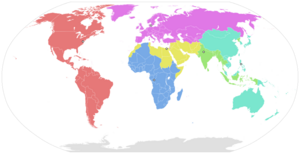
WHO's regional divisions were created between 1949 and 1952. They are based on WHO's constitution, which allows WHO to "establish a [single] regional organization to meet the special needs of [each defined] area." Many decisions are made at the regional level, including important talks about WHO's budget and choosing members for the next assembly.
Each region has a regional committee, which usually meets once a year. Representatives from each member country in the region attend. For example, Palestine attends meetings of the Eastern Mediterranean Regional Office. Each region also has a regional office. A director, chosen by the Regional Committee, leads each regional office. Since 1999, regional directors serve for a five-year term, which can be renewed once.
Each regional committee of WHO includes all the heads of health departments from the governments in that region. Besides choosing the regional director, the regional committee also sets the rules for how health policies from the World Health Assembly are put into action in the region. The regional committee also checks the progress of WHO's work in the region. The regional director is basically the head of WHO for their region. The regional director manages health experts at the regional offices and special centers. The regional director also directly supervises the heads of WHO country offices in their region.
The strong position of the regional offices has been criticized in WHO's history for making it less effective. There have been unsuccessful attempts to bring them more closely into a "One WHO" system. Programs for specific diseases, like the smallpox eradication program, were set up with more direct structures that bypassed the regional offices.
| Region | Headquarters | Notes |
|---|---|---|
| Africa | Brazzaville, Republic of the Congo | AFRO includes most of Africa, except for Egypt, Sudan, Djibouti, Tunisia, Libya, Somalia, and Morocco (which are under EMRO). The regional director is Matshidiso Moeti from Botswana (since 2015). |
| Europe | Copenhagen, Denmark | EURO includes all of Europe (except Liechtenstein), Israel, and all countries that were part of the former USSR. The regional director is Hans Kluge from Belgium (since 2020). |
| South-East Asia | New Delhi, India | North Korea is served by SEARO. The regional director is Catharina Boehme (acting) from Germany (since 2025). |
| Eastern Mediterranean | Cairo, Egypt | The Eastern Mediterranean Regional Office serves African countries not in AFRO, and all Middle Eastern countries except Israel. Pakistan is served by EMRO. The regional director is Ahmed Al-Mandhari from Oman (since 2018). |
| Western Pacific | Manila, the Philippines | WPRO covers all Asian countries not served by SEARO, EMRO, or EURO, and all countries in Oceania. South Korea is served by WPRO. The acting regional director is Zsuzsanna Jakab from Hungary, who is also the current WHO Deputy Director-General (since 2023). |
| The Americas | Washington, D.C., United States | Also known as the Pan American Health Organization (PAHO), it covers the Americas. The WHO regional director is Jarbas Barbosa from Brazil (since 2023). |
Images for kids
-
Three former directors of the Global Smallpox Eradication Programme read the news that smallpox had been globally eradicated, 1980.
More to Explore
- Alliance for Healthy Cities, a group of cities working for health
- Global mental health
- Health promotion
- Healthy city
- International Labour Organization
- The Partnership for Maternal, Newborn and Child Health
- Timeline of global health
- WHO Framework Convention on Tobacco Control
- WHO Guidelines for drinking-water quality
- World Hearing Day
See also
 In Spanish: Organización Mundial de la Salud para niños
In Spanish: Organización Mundial de la Salud para niños


